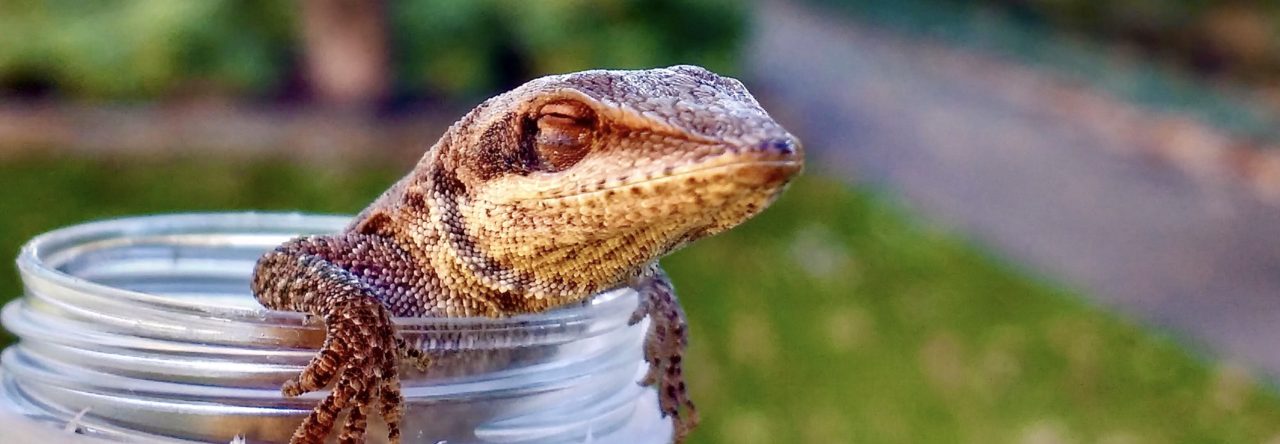The Anolis carolinensis – A. sagrei interaction in the SE United States has been discussed on quite a few occasions on this site (see [1], [2], [3], [4], [5], [6] and others). Anolis carolinensis is the only anole native to the US but A. sagrei has invaded much of the former’s range by inhabiting nearly all of Florida, some of southern Georgia, and parts of Louisiana and Texas. The Anolis community has focused a great deal of attention asking: what is the ecological, behavioral, and evolutionary effect of A. sagrei on A. carolinensis.
A new paper by Jessica Edwards and Simon Lailvaux of the University of New Orleans, “Display behavior and habitat use in single and mixed populations of Anolis carolinensis and Anolis sagrei lizards,” explores this interaction even further.
The authors studied three different urban populations: (1) an A. carolinensis-only population, (2) an A. sagrei-only population, and (3) a mixed population to determine effect of sympatric congeners on display behavior. Previous work by Tom Jenssen’s group showed that A. carolinensis has three conserved, stereotyped display forms (called A, B, and C) that comprise different combinations of head bobbing, pushups, and dewlap displays. Though the context of the displays is still unclear, they are likely used in some combination for courtship, aggression, and territorial defense.
Edwards and Lailvaux therefore hypothesized that proportion of each display used by males in a population would be changed by the presence or absence of a second Anolis species. They also hypothesized that both A. carolinensis and A. sagrei would display at higher rates for longer in mixed populations.
Using a combination of video-taping and display analysis, Edwards and Lailvaux collected data from 21 A. carolinensis and 28 A. sagrei males from the mixed population and 29 A. sagrei males and 23 A. carolinensis males from each single-species population. They tallied the duration and number of displays, dewlap extensions, push-ups, head bobs, and also categorized A. carolinensis displays by display type (A, B, or C). They also recorded perch height, a typical Anolis metric of interest for habitat partitioning.
They found that A. carolinensis perches significantly higher in the presence of A. sagrei, consistent with previous studies. A. sagrei’s perch height is not significantly affected by the presence of A. carolinensis, suggesting that the interaction is asymmetric (Fig. 1).
For display behavior, they found that A. carolinensis at the mixed site used significantly different proportions of A, B, and C displays compared to the single-species site, driven largely by the higher number of C displays (Fig. 2). The authors suggested that C displays, which are used more often in long distance signaling, may be required in the mixed A. carolinensis population because of the increased perch height used by this population (i.e., increased perch height may mean longer inter-individual distances).
A more compelling explanation for the increase in C displays offered by the authors relies on differences in age structure between sites. Mixed populations of A. carolinensis had males that were much younger and smaller than the single-species site, and younger A. carolinensis have been reported to use more C displays. Indeed, pre-sagrei invasion data suggest that male A. carolinensis used to use a higher proportion of A and B displays at the mixed site than they now do post-invasion.
Other aspects of the display (time, single or volley displays) did not differ between A. carolinensis populations.
Male A. sagrei did not differ significantly in time spent displaying or dewlap display frequency between sites, although they did have higher frequency of push-up displays in the single-species site (Fig. 3), potentially the result of higher A. sagrei density at the single-species site.
This work highlights the importance of considering the behavioral impacts of invasive species. Because behavior can serve to both drive and inhibit evolution, understanding how A. carolinensis and A. sagrei interact may help us predict how A. carolinensis will fare over time as A. sagrei overlaps with A. carolinensis over the latter’s entire range.
- DNA Sequencing from Formalin-Preserved Specimens - December 16, 2014
- Sans the Claws, Anoles Present Under The Trees? - December 5, 2014
- Out Damned Spot! Or, How They’d Be Loving If They Weren’t Fighting - November 18, 2014






1 Pingback